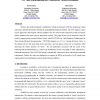Free Online Productivity Tools
i2Speak
i2Symbol
i2OCR
iTex2Img
iWeb2Print
iWeb2Shot
i2Type
iPdf2Split
iPdf2Merge
i2Bopomofo
i2Arabic
i2Style
i2Image
i2PDF
iLatex2Rtf
Sci2ools
ICWL
2005
Springer
2005
Springer
P2P Video Synchronization in a Collaborative Virtual Environment
We have previously developed a collaborative virtual environment (CVE) for small-group virtual classrooms, intended for distance learning by geographically dispersed students. The CVE employs a peerto-peer approach to the frequent real-time updates to the 3D virtual worlds required by avatar movements (fellow students in the same room are depicted by avatars). This paper focuses on our extension to the P2P model to support group viewing of lecture videos, called VECTORS, for Video Enhanced Collaboration for Team Oriented Remote Synchronization. VECTORS supports synchronized viewing of lecture videos, so the students all see “the same thing at the same time”, and can pause, rewind, etc. in synchrony while discussing the lecture material via “chat”. We are particularly concerned with the needs of the technologically disenfranchised, e.g., whose only Web/Internet access if via dialup or other relatively lowbandwidth networking. Thus VECTORS employs semantically compressed videos ...
| Added | 27 Jun 2010 |
| Updated | 27 Jun 2010 |
| Type | Conference |
| Year | 2005 |
| Where | ICWL |
| Authors | Suhit Gupta, Gail E. Kaiser |
Comments (0)

